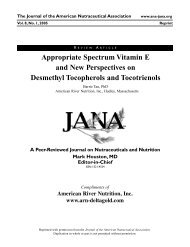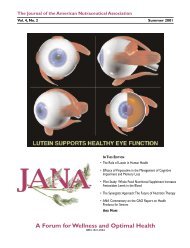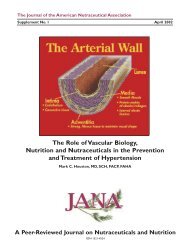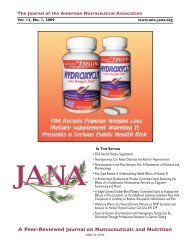JANA Vol 9 #1 - American Nutraceutical Association
JANA Vol 9 #1 - American Nutraceutical Association
JANA Vol 9 #1 - American Nutraceutical Association
You also want an ePaper? Increase the reach of your titles
YUMPU automatically turns print PDFs into web optimized ePapers that Google loves.
Glory, a two-year old Sheltie, in Birmingham, Alabama,<br />
works with toddler at the Bell Center for Early Intervention<br />
Programs, which focus on developmentally delayed children.<br />
ities led Franklin to launch other innovative programs targeting<br />
additional groups.<br />
HIP began sending Pet Partner ® teams to the locked<br />
psychiatric unit at Children’s Hospital to visit patients age<br />
12 to 18 who had been admitted for suicide attempts, psychosis,<br />
aggressive behavior, mood instability, sexually “acting<br />
out” behavior, eating disorders, depression, and alcohol<br />
and drug abuse.<br />
“I’ve seen an individual smile for the first time since his<br />
admission just at the sight of (animal therapy dogs) Molly,<br />
Sarge and Calypso,” states Lisa Trentham, an occupational<br />
therapist previously at the unit. “I’ve also witnessed kids<br />
talking expressively to one of the pets when I’d been unable<br />
to facilitate such interaction, and I’ve seen kids who have<br />
been too depressed to get out of bed make an effort to attend<br />
group session just to see the pets.”<br />
Trentham also feels that therapy pets are extremely<br />
effective in working with children who have abused animals.<br />
These children may have sacrificed animals for supposed<br />
‘religious’ beliefs, are involved with dog fighting,<br />
have killed the family pet due to command hallucinations or<br />
to get parental attention, have put their pet in the microwave<br />
or dryer, or have branded an animal with a gang sign.<br />
“To watch individuals with a history of animal abuse<br />
pet these animals with gentle hands and look into their eyes<br />
Therapy dog Molly working with toddler undergoing<br />
treatment at Children’s Hospital in Birmingham,<br />
Alabama.<br />
and see reflected back a bit of compassion is a wonderful<br />
sight to behold,” she adds. “Considering the seriousness of<br />
these actions, I view myself and everyone involved with<br />
animal-assisted therapy as steps in the ladder to helping<br />
overcome animal cruelty. And the pets don’t just reach the<br />
children, they reach the staff as well. Assisting with the<br />
burnout that can occur among mental health professionals<br />
is an added benefit of animal-assisted therapy.”<br />
HIP is also involved in an experimental neuromotor<br />
rehabilitation program that has attracted international attention<br />
due to its success. UAB’s Pediatric Neuromotor<br />
Research Clinic launched ACQUIREc, an exciting new therapy<br />
to assist children with neuromotor disorders resulting<br />
from cerebral palsy, traumatic brain injury, and other neurological<br />
injuries. The acronym embodies the program’s concept<br />
of Acquisition of new motor skills through Continuous<br />
practice and shaping to produce Quality movement of the<br />
Upper extremity through Intense therapy and Reinforcement<br />
in Everyday patterns and places. The subscript “c” indicates<br />
the important component of casting (as a way of immobilizing<br />
a body part so that its complement can be strengthened).<br />
Therapy involves three major components:<br />
• Therapy must be given many hours a day for many consecutive<br />
days to produce changes in the brain and motor<br />
behavior.<br />
• The weaker upper extremity must be facilitated and<br />
trained in many specific tasks appropriate to the child’s<br />
behavior.<br />
• The stronger upper extremity must be completely<br />
restrained for an extended time.<br />
The program’s administrators felt that HIP could play an<br />
important role in inducing the children to perform tasks with<br />
their weaker extremity in the presence of therapy animals.<br />
Stacie Williams, an occupational therapist previously<br />
with the ACQUIREc program, was working with four-year<br />
old Tyler, whose parents had come to UAB from their home<br />
in Pennsylvania to work on improving the fine-motor skills<br />
of Tyler’s right hand. “His less-affected left arm and hand<br />
10 <strong>JANA</strong> <strong>Vol</strong>. 9, No. 1, 2006









